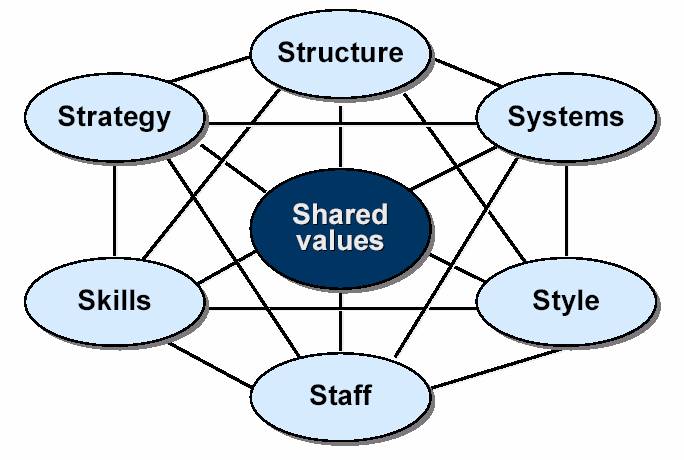Organization Development Model Integration

 “Burke and Litwin (1992) model proposed a causal model of organizational performance and change. This open system model, considers inputs, processes, and outputs in relationship with the external environment.” In order to provide comprehensive variables external environments, along with individual and organizational performance are determinants of the climate needs, structural management and leadership strategy envisionment. Burke and Litwin contrasts Mckinsey in that, both external and internal climate/environments either diagnose a problem within the organisation or create an action plan for a change initiative. In addition, Burke and Litwin take a top down approach in diagnosing organizational effectiveness, whereas Mckinsey 7-S takes a holistic less structured approach in change efforts that do not consider any one aspect of an organization in isolation.
“Burke and Litwin (1992) model proposed a causal model of organizational performance and change. This open system model, considers inputs, processes, and outputs in relationship with the external environment.” In order to provide comprehensive variables external environments, along with individual and organizational performance are determinants of the climate needs, structural management and leadership strategy envisionment. Burke and Litwin contrasts Mckinsey in that, both external and internal climate/environments either diagnose a problem within the organisation or create an action plan for a change initiative. In addition, Burke and Litwin take a top down approach in diagnosing organizational effectiveness, whereas Mckinsey 7-S takes a holistic less structured approach in change efforts that do not consider any one aspect of an organization in isolation.
“The McKinsey 7-S framework lacks the environmental component in open systems model, by adding outputs and the interaction between the transformational process and the environment.McKinsey’s 7-S framework examines the elements that give a holistic understanding of an organization.” With a doctor–patient approach, the 7-S collects and analyzes organizational data, engaging the organization’s members as both participants and researchers who as a result can contribute to joint diagnosis.Mckinsey’s 7-S framework’s holistic approach contrasts burke and Litwin, in that internal climate/environments are considered the root causes for joint diagnosis. Mckinsey 7-S is applied where in order for it to operate successfully, all the elements in this model must align synergistically together.
Integration: Leading shared values in organizational strategy by means of a clear mission creates a structure where management can convey alike systems in place motivating organizational performance. Keeping into account techniques, such that individual staff skills and style can frame climate needs in the basis of output. As external environmental factors are considered, the organization can effectively integrate these components and adjust feedback into a shared value that becomes a part of the accepted culture. In hindsight, while the Burke and Litwin framework does not label staff and style, the remaining shared values of Mckinsey 7-S are represented. Staff is a representation of an input of resources. Under leadership and management, staff should follow. The integration of these three levels includes all stakeholders. In terms of style, leadership sets the tone for style, therefore the leadership style will be an input of the mission, strategy and culture.
Implementation: The integrated change model brings in change in the performance of a team or organization by establishing links between internal and external factors which affect performance. This change model assesses the organizational as well as environmental factors which can be tweaked for effectiveness in discovering the “problem(s)”. The change model outlines a framework of affecting factors which manipulate diagnostic theories in consideration of whatever the type of change ie. restructuring, new processes, organizational merger, new systems, change of leadership. Furthermore, the model can be used to understand how the organizational elements are interrelated in improving performance;
Usability:
The model can be applied to almost any inconsistency between internal elements and external elements to make sure they are all contributing feedback to the shared goals and values. The process of diagnosing current state in terms of these elements and determining the ultimate state for each of the factors can depict where the need for change is coming from and the collateral impact of proposed changes. This framework can be used to depict impact that changes in one area have on all the other areas of development in implementation of a change, utilizing self discovery of how to make the changes needed analyzing;
- The likely effects of future changes within a company.
- Aligning of departments and processes during a merger or acquisition.
- How best to implement a proposed strategy.
- Changes in structure, practices and systems
Critique: In theory these integrated models can be used as a best practice to store and apply with each time the organization is commencing change. The real question is what are we really doing versus our best practice? How efficiently is every senior leader applying this with their team? Does the team have a common goal? How long can this best practice actually be reinforced? We operate by principal where utilizing best practices efficiently for a course of segments and celebrating their success grants merit to their usage. However adopting te model integration as a best practice should be used for powerful change, using haphazardly can minimize its impact when discovering major cultural change expectancies, for example. Having a mechanism to present early review of models can also grant buy in for usage with the team on selectively using for important change initiatives, thereby withstanding the integrity of model application as a best practice.
Sources: